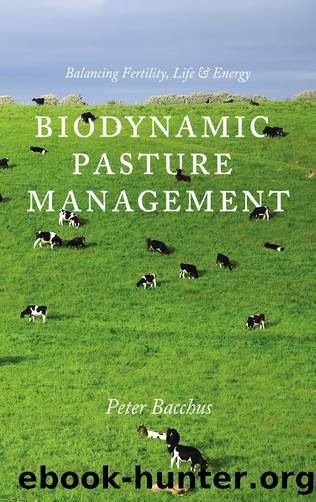Biodynamic Pasture Management: Balancing Fertility, Life & Energy by Peter Bacchus

Author:Peter Bacchus [Peter Bacchus]
Language: eng
Format: epub
Publisher: Acres U.S.A.
Published: 2013-12-17T00:00:00+00:00
* * *
1 The Bray 2 test indicates soil reserves of phosphorus, in comparison to the Mehlich 3 test which is a softer extraction, giving a better idea of the level of phosphorus available to the plant. In New Zealand the Resin P. test has a similar score to the Mehlich 3 test. For example, often with a soil test where the Mehlich 3 test shows 55 ppm, the Bray 2 test will show 120 ppm.
8
Biodynamics & Building Organs
THE aim of biodynamics is to create as much biodiversity as possible and integrate it all into a cohesive unit. Have you noticed that this is how nature works? Rarely do you see just one species on its own. Generally, in the natural woodlands of Europe and the United States, and the New Zealand native bush, there is a mix of many different species of trees, ferns, mosses etc., with many different insects, beetles, spiders, birds and fish living amongst them. Even if your farm specializes in one area, such as dairy or an avocado orchard, you can still build a lot of biodiversity into the shelter belts, pasture, bush and woodlots.
When a farm has been managed well using a biodynamic system, after some years it develops its own unique character or individuality which is appropriate for the particular people, climate, soil and other features of that farm. This can be contrasted with the aim of soluble fertilizer use in farming, which is to make all farms as similar as possible so that they can all be treated according to a single recipe. When you really understand biodynamics you do not just use recipes, you make decisions based on what you see and hear in your environment, and then treat your farm in a way that optimizes its potential.
I remember visiting a small farm in northern Georgia in the United States run by Hugh Lovel. He kept a few cows and grew a diverse range of crops such as corn, soy beans, dwarf beans, and an assortment of vegetables to suit his CSA clients. The farm seemed very much an expression of his personality. It was also very productive. He showed me sweet corn growing very prolifically on land that had not recently been fertilized. The plants were producing so much sugar that it was dripping from the stool roots just above the soil, and also feeding myriads of soil life around the plant roots.
A farm can be thought of as an individual in the same way as a human is an individual. Rudolf Steiner described four bodily aspects of a human: the ego (the âI am-nessâ), astral body (the movement, feeling, the soul), etheric body (the flowing life energy), and physical body (the part we all see and what is left when we die).
Steinerâs human aspects can easily be related to a farm and the corresponding aspects of a farm are:
The farmer is the ego or
Download
This site does not store any files on its server. We only index and link to content provided by other sites. Please contact the content providers to delete copyright contents if any and email us, we'll remove relevant links or contents immediately.
Craft Beer for the Homebrewer by Michael Agnew(18140)
Marijuana Grower's Handbook by Ed Rosenthal(3619)
Barkskins by Annie Proulx(3312)
Project Animal Farm: An Accidental Journey into the Secret World of Farming and the Truth About Our Food by Sonia Faruqi(3177)
The Plant Messiah by Carlos Magdalena(2883)
Red Famine: Stalin's War on Ukraine by Anne Applebaum(2873)
0041152001443424520 .pdf by Unknown(2784)
Organic Mushroom Farming and Mycoremediation by Tradd Cotter(2626)
In the Woods by Tana French(2532)
Beer is proof God loves us by Charles W. Bamforth(2370)
7-14 Days by Noah Waters(2361)
Reservoir 13 by Jon McGregor(2242)
Borders by unknow(2227)
Meathooked by Marta Zaraska(2220)
The Art of Making Gelato by Morgan Morano(2216)
Birds, Beasts and Relatives by Gerald Durrell(2175)
Between Two Fires by Christopher Buehlman(2164)
The 7 Habits of Highly Effective People: Powerful Lessons in Personal Change (25th Anniversary Edition) by Covey Stephen R(2139)
The Lean Farm Guide to Growing Vegetables: More In-Depth Lean Techniques for Efficient Organic Production by Ben Hartman(2096)
